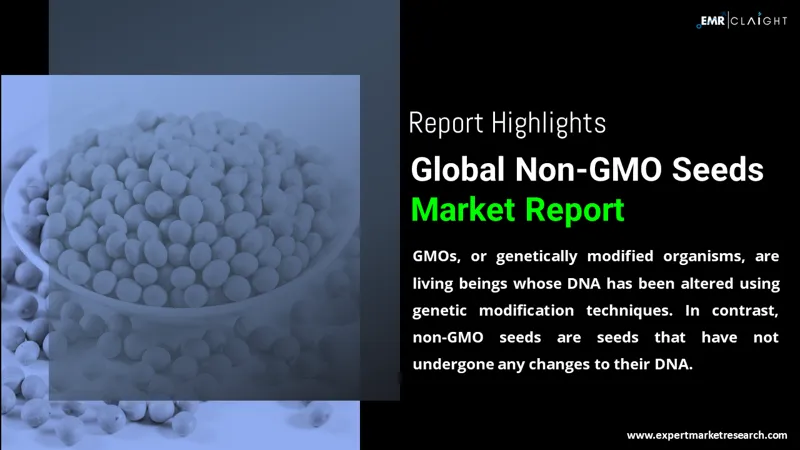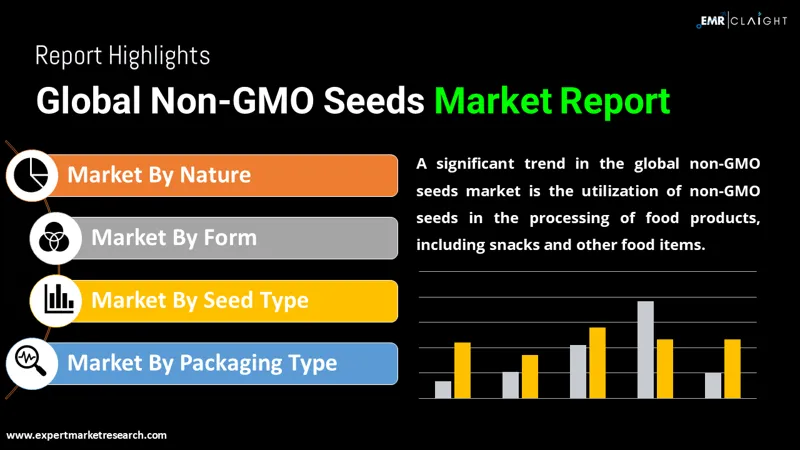
Consumer Insights
Uncover trends and behaviors shaping consumer choices today
Procurement Insights
Optimize your sourcing strategy with key market data
Industry Stats
Stay ahead with the latest trends and market analysis.
The global non-GMO seeds market is significantly supported by the growth of seed market, which attained USD 89.13 Billion in 2025. The seed market is projected to grow at a CAGR of 7.00% between 2026 and 2035, to attain USD 175.33 Billion by 2035.
Base Year
Historical Period
Forecast Period
Compound Annual Growth Rate
7%
Value in USD Billion
2026-2035
*this image is indicative*
Non-GMO seeds help farmers save money while also increasing the size of their yields, consequently boosting the market growth of non-GMO seeds. Consumers are preferring safer and better-produced food products with non-GMO project validated certifications over GMO food products because of their lower cost and more natural produce.

Read more about this report - REQUEST FREE SAMPLE COPY IN PDF
Growing health consciousness among consumers, as well as the growing popularity of vegetarian and vegan lifestyles, are driving the demand for foods made with organic and non-GMO seeds. During the forecast period, the popularity of organic food products is expected to increase, which will indirectly boost the growth of the non-GMO seeds industry.

Read more about this report - REQUEST FREE SAMPLE COPY IN PDF
GMOs, or genetically modified organisms, are organisms that have had their DNA changed through a method known as genetic modification. As a result, non-GMO seeds are seeds that haven't had their DNA changed in any way.
By nature, the market is divided into:
On the basis of form, the market is bifurcated into:
Based on seed type, the market is segmented into:
By packaging type, the market is divided into:
The regional markets for the product include:
Non-GMO seeds are largely influenced by agricultural economics. Non-GMO seeds are cheap, and as opposed to genetically modified seeds, they can cost up to half as much. As a result, further usage of non-GMO seeds as an ingredient in food products during processing into snacks or other food products benefits both producers and customers. Over time, it has been observed that non-GMO crops generate higher yields than GMO seeds. The yield is determined by the genetics of the crop. One of the factors driving the growth of the market is the growing number of non-GMO product launches in the food and beverage industry. As a result of these significant advantages over genetically modified seeds, the demand for non-GMO seeds is projected to rise in the forecast period.
The report gives a detailed analysis of the following key players in the global non-GMO seeds market, covering their competitive landscape, capacity, and latest developments like mergers, acquisitions, and investments, expansions of capacity, and plant turnarounds:
The comprehensive EMR report provides an in-depth assessment of the market based on the Porter's five forces model along with giving a SWOT analysis.




*While we strive to always give you current and accurate information, the numbers depicted on the website are indicative and may differ from the actual numbers in the main report. At Expert Market Research, we aim to bring you the latest insights and trends in the market. Using our analyses and forecasts, stakeholders can understand the market dynamics, navigate challenges, and capitalize on opportunities to make data-driven strategic decisions.*
Get in touch with us for a customized solution tailored to your unique requirements and save upto 35%!
The global non-GMO seeds market is significantly supported by the growth of seed market, which attained USD 89.13 Billion in 2025.
The seed market is projected to grow at a CAGR of 7.00% between 2026 and 2035.
The seed market is estimated to witness a healthy growth in the forecast period of 2026-2035 to reach USD 175.33 Billion by 2035.
The major market drivers include the growing preference for safer and better-produced food products with non-GMO project-validated certifications among consumers, rising health consciousness, and the growing popularity of vegetarian and vegan lifestyles.
The key trends guiding the market demand include the growing popularity of organic food products, the low cost of non-GMO seeds, and the growing number of non-GMO product launches.
The major regional markets for the product include North America, Europe, the Asia Pacific, Latin America, and the Middle East and Africa.
The major nature segments of the market include organic and conventional.
The significant forms of non-GMO seeds are whole, and grits, among others.
The major seed types include vegetable, fruits, oilseeds and pulses, cereals and grains, herbs, and flowers, among others.
The significant packaging types of non-GMO seeds are tubs/jars, pouches, and gunny bags, among others.
The major players in the market are Cargill Inc., BASF SE, Albert Lea Seed, Prairie Hybrids, Spectrum Premium Non-GMO, and Sentinel Seeds, LLC, among others.
Explore our key highlights of the report and gain a concise overview of key findings, trends, and actionable insights that will empower your strategic decisions.
| REPORT FEATURES | DETAILS |
| Base Year | 2025 |
| Historical Period | 2019-2025 |
| Forecast Period | 2026-2035 |
| Scope of the Report |
Historical and Forecast Trends, Industry Drivers and Constraints, Historical and Forecast Market Analysis by Segment:
|
| Breakup by Nature |
|
| Breakup by Form |
|
| Breakup by Seed Type |
|
| Breakup by Packaging Type |
|
| Breakup by Region |
|
| Market Dynamics |
|
| Competitive Landscape |
|
| Companies Covered |
|
| Report Price and Purchase Option | Explore our purchase options that are best suited to your resources and industry needs. |
| Delivery Format | Delivered as an attached PDF and Excel through email, with an option of receiving an editable PPT, according to the purchase option. |
Datasheet
One User
USD 2,499
USD 2,249
tax inclusive*
Single User License
One User
USD 3,999
USD 3,599
tax inclusive*
Five User License
Five User
USD 4,999
USD 4,249
tax inclusive*
Corporate License
Unlimited Users
USD 5,999
USD 5,099
tax inclusive*
*Please note that the prices mentioned below are starting prices for each bundle type. Kindly contact our team for further details.*
Flash Bundle
Small Business Bundle
Growth Bundle
Enterprise Bundle
*Please note that the prices mentioned below are starting prices for each bundle type. Kindly contact our team for further details.*
Flash Bundle
Number of Reports: 3
20%
tax inclusive*
Small Business Bundle
Number of Reports: 5
25%
tax inclusive*
Growth Bundle
Number of Reports: 8
30%
tax inclusive*
Enterprise Bundle
Number of Reports: 10
35%
tax inclusive*
How To Order

Select License Type
Choose the right license for your needs and access rights.

Click on ‘Buy Now’
Add the report to your cart with one click and proceed to register.

Select Mode of Payment
Choose a payment option for a secure checkout. You will be redirected accordingly.
Gain insights to stay ahead and seize opportunities.

Get insights & trends for a competitive edge.

Track prices with detailed trend reports.

Analyse trade data for supply chain insights.

Leverage cost reports for smart savings

Enhance supply chain with partnerships.

Connect For More Information
Our expert team of analysts will offer full support and resolve any queries regarding the report, before and after the purchase.
Our expert team of analysts will offer full support and resolve any queries regarding the report, before and after the purchase.
We employ meticulous research methods, blending advanced analytics and expert insights to deliver accurate, actionable industry intelligence, staying ahead of competitors.
Our skilled analysts offer unparalleled competitive advantage with detailed insights on current and emerging markets, ensuring your strategic edge.
We offer an in-depth yet simplified presentation of industry insights and analysis to meet your specific requirements effectively.
Share